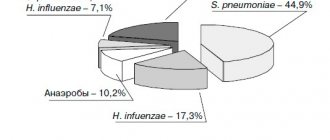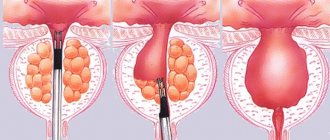August 31, 2020
Chlamydia is an infection transmitted primarily through sexual contact; the causative agent is chlamydia (Chlamydia trachomatis).
From the article you will learn what kind of disease this is, why it is dangerous and how it is transmitted. Chlamydia is an infection transmitted primarily through sexual contact; the causative agent is chlamydia (Chlamydia trachomatis). According to WHO, urogenital chlamydia is one of the most common diseases among STDs. Absolutely all sexually active people can get chlamydia; the greater the number of sexual partners, the higher the risk of infection. About 75% of new cases of the disease are registered among women under 25 years of age, and by the age of 30, approximately 50% of sexually active women have the disease. For sexually active men, the risk of infection is highest between the ages of 20 and 24 years.
Chlamydia trachomatis is able to actively multiply in healthy human cells and absorb from them all the enzymes necessary for its life. The incubation period for the development of chlamydia ranges from 5-7 days to 3-6 weeks (on average 20-30 days). According to doctors, the main way of contracting chlamydia is through sexual contact. However, chlamydia can enter the human body through everyday life or from mother to child, during its passage through the birth canal, inseminated by pathogenic bacteria.
The following methods of transmission of infection are officially registered:
- Sexual contact, including vaginal, anal and oral sex. The probability of transmission from a single sexual act is 68% from an infected woman to a man and 25% from an infected man to a woman.
- “Vertical” during childbirth - infection of newborns (conjunctivitis or pneumonia) during childbirth from a sick mother while passing through the birth canal.
- The contact and household route of infection with chlamydia is rarely recorded: through bedding and toiletries, underwear, etc. Cases of infection of the mucous membrane of the conjunctiva of the eye (discharge from the genital organs) have been described.
The causative agent of the disease
The causative agent of chlamydia in men and women is the bacterium Chlamydia trachomatis. It is immobile and lives inside cells. About a million people are infected with it every year, of whom more than half are men. The total number of cases is approaching a billion, and the male gender predominates. According to statistics, from 5 to 15% of people who are sexually active have chlamydia.
The infection is dangerous due to its manifestations and complications, these include:
- prostatitis;
- impotence;
- inflammation of the testicle and its appendages;
- narrowing of the urethra;
- joint damage;
- inflammation of the mucous membranes of the eyes;
- pain in the pelvic area.
Another danger of chlamydia is the ability to transform into L-forms, i.e. into a sleeping state. In this case, taking antibiotics does not have a significant effect on the pathogen; the infection remains in the host’s body. When the immune system is weakened, the disease worsens.
There are 9 types of chlamydia, a third of them pose a threat to human health:
- Chlamydia trachomatis. Causes STDs.
- Chlamydia pneumonia. When ingested, it attacks the lungs, causing pneumonia, especially in children, young people and in crowded communities (nursing homes, schools, prisons, etc.).
- Chlamydia psittaci. Transmitted from parrots. Causes pneumonitis - a specific inflammation in the lungs.
All chlamydia can occur not only as a pronounced infectious process, but also subclinically, i.e. with few symptoms.
Classification of chlamydia
Many people think that chlamydia affects only the genitourinary organs, but in fact this is not the case. All chlamydia are included in the order Chlamydiales. One of the families Chlamydiaceae, genus Chlamydia and Chlamydophilia, includes several species of microorganisms, including:
- Chlamydia psittaci
- Chlamydia pneumonia
- Chlamydia pecorum
- Chlamydia trachomatis
C.psittaci can lead to the development of atypical pneumonia, pyelonephritis, encephalomyocarditis and arthritis, C.pneumonia causes the development of acute respiratory diseases and one form of pneumonia, and C.pecorum is currently poorly understood and is associated with diseases in cattle. The role of this microorganism in the pathogenesis of human inflammation is unknown.
The extensive subgroup C. trachomatis includes more than 15 species of the pathogen, which is the most significant pathogen for humans and is capable of infecting internal and external organs, causing a number of dangerous diseases, including UGC.iii
Clinical symptoms
Signs of chlamydia in men can be tracked by certain symptoms.
The disease is characterized by:
- Itching in the urethra.
- Burning, pain when urinating (urine may be cloudy).
- Light, almost colorless discharge from the urethra.
- Frequent urge to urinate.
- Redness and slight swelling in the area of the urethral outlet.
- Swelling, sharp pain, local increase in temperature in the scrotum area.
- Pain in the scrotum, rectum.
- Pain in the lumbar and sacral regions, and even in the lower extremities (along the sciatic nerve).
- Possible Reiter's triad: urethritis, conjunctivitis and arthritis. As a rule, one of the large joints is affected, most often on one side. (for example, knee, hip or ankle).
- Discomfort during defecation (typical for damage to the rectum and prostate).
Possible Reiter's triad: urethritis, conjunctivitis and arthritis. As a rule, one of the large joints (for example, knee, hip or ankle) is affected unilaterally. Often the patient is worried only about the joints and he turns to therapists and rheumatologists. Therefore, it is important to always remember that chlamydia can affect not only the urogenital tract, but also the joints.
Inna Zhikhoreva
Dermatologist, Venereologist, Hair diseases
Ways of infection with chlamydia
The causative agent of chlamydial infection is unstable in the external environment and is sensitive to high temperatures. It almost instantly loses its aggressive properties when dried, exposed to chemicals and ultraviolet rays.
Chlamydia infection usually occurs through unprotected sex. Scientists have established contact and vertical mechanisms of transmission of the pathogen. The implementation of the contact mechanism is possible during genital-genital, genital-anal and oral-genital contacts. There is also a household route of transmission of chlamydia in the family through bedding and toiletries, underwear and shared items with an infected person. The vertical mechanism of infection with chlamydia occurs through the placenta and intrapartum, during childbirth.
Today, this disease is epidemiological in nature. This is facilitated by the lack of genetically determined immunity in humans against this infection. The disease suffered in the past does not lead to the creation of stable immunity, which can protect a person from re-infection.iii A urologist treats chlamydia in men.
Diagnosis of the disease
- Chlamydia can be detected using the following methods:
- PCR – main analysis, sensitivity and specificity – 100%. Finds the DNA of the pathogen. Completion time: 2–3 days. For this purpose, a swab is taken from the urethra or a scraping from the pharynx.
- ELISA - determination of antibodies in the blood secreted by the body in response to the introduction of chlamydia. Appear 10–20 days after infection. The accuracy is no more than 60%, due to the fact that antibodies persist for a long time after treatment and it is not always clear whether this is a new round of disease or immune memory.
- The cultural method is the inoculation of material obtained from a scraping or smear onto nutrient media. The most labor-intensive and expensive, results need to wait several days. Determines the sensitivity of chlamydia to antibiotics to select therapy.
- The immunofluorescence reaction is a complex method that requires experience and professionalism of the performer. The material obtained by scraping or smear is stained, after which the bacteria begin to glow under a microscope. Accuracy no more than 50%.
Detect it in time!
One of the most sensitive tests that quickly and with a high degree of reliability detects C. trachomatis has been and remains PCR - polymerase chain reaction. It virtually eliminates the possibility of obtaining a false result. The PCR technique is based on the so-called amplification method, which allows you to significantly increase the concentration of DNA in a material sample.
Another popular diagnostic method, DIF (direct immunofluorescence analysis), is usually used to confirm the results of other tests. It is not informative enough when the number of bacteria in the source material is small.
Diagnosing chlamydia using a blood test that detects antibodies (immunoglobulins) to C. trachomatis is most often a thankless task. The diagnostic value of serological research methods is low: some antibodies remain in the blood for a long time after successful treatment of chlamydia, and sometimes for a lifetime. Therefore, it is not always possible to distinguish an active infection from a reminder of a distant, troubled past.
Early treatment
To effectively treat chlamydia in men, it is necessary to act on the causative agent of the disease.
In the primary acute process, antibacterial drugs from the group of macrolides (Azithromycin, Clarithromycin, Josamycin, Midekamycin) and tetracyclines (Doxycycline) showed good results.
Doctor's advice
It is important to take a responsible approach to choosing a sexual partner, as well as to use barrier methods of contraception, since chlamydia is much easier to prevent than to treat.
Inna Zhikhoreva Dermatologist, Venereologist, Hair diseases
However, treatment with drugs from a number of tetracycline antibiotics has a number of disadvantages:
- A course of treatment for 1 week does not achieve the desired result. According to research, relapse of the disease occurs in 15-20% of cases with this treatment regimen.
- Extending the time of taking medications to 14 days is dangerous due to the re-development of infection in 15% of cases.
- Treatment for 21 days avoids relapses, as it affects 7 cycles of development of the infectious agent. However, such a long-term regimen is inconvenient for patients: violations in taking antibiotics often occur. Skipping pills or not using them regularly can lead to the development of chlamydia resistance to this drug. In addition, long-term use of drugs can provoke the development of fungal infections, as well as dysbiosis of the digestive tract. To prevent these complications, it is necessary to prescribe antifungal drugs (Nystatin, Levorin, Ketoconazole), as well as eubiotics (Linex).
Considering the above disadvantages of antibiotics from the tetracycline group, treatment with macrolides is the most convenient.
The drug Azithromycin (Sumamed) is especially effective.
Advantages of the drug Azithromycin :
- A convenient treatment regimen is a single dose of 1 g of Azithromycin.
- The effect of the drug lasts 10 days even after a single dose (this effect is created due to the half-life).
- A simple scheme ensures 100% compliance with the doctor’s recommendations.
- Azithromycin persists for a long time in tissues affected by the inflammatory process.
- Low percentage of side effects.
- The antibiotic affects intracellular pathogens due to the ability to accumulate inside cells (in particular, phagocytes). This is very important in the treatment of chlamydia, since chlamydia is completely dependent on the host cell.
Sources
- Beatty V.L. et al.: Persistent chlamydia: from cell culture to the paradigm of chlamydia pathogenesis.
- Bergan T, Gjonnes M: Penetration of erythromycin into the female pelvic organs.
- Boslego JW et al: A prospective randomized trial of ofloxacin versus doxycycline in the treatment of uncomplicated male urethritis.
- Dayek Z: Treatment of uncomplicated urethral and cervical infections caused by Chlamydia trachomatis with a single oral dose of azithromycin.
- De Punzio S, et al: Epidemiology and therapy of genital infections in women caused by Chlamydia trachomatis. J. Chemother.
- Domeika M., Mard P.A.: The ABCs of chlamydia.
- Dilewski J, et al: Comparison of spiramycin and doxycycline for the treatment of genital infections caused by Chlamydia trachomatis.
- Hooton TM et al: Ciprofloxacin versus doxycycline for nongonococcal urethritis.
- Hoyme UB et al.: Roxithromycin versus doxycycline in the treatment of cervicitis.
- Jones RB: New treatments for Chlamydia trachomatis.
- Lassus A, Seppala A: Roxithromycin for nongonococcal urethritis.
- Martin DH et al: A controlled trial of single dose azithromycin for the treatment of chlamydial urethritis and cervicitis.
- Mogabgab WJ: Recent developments in the treatment of sexually transmitted diseases.
- Perea EJ et al.: Comparative in vitro activity of sparfloxacin against genital pathogens. Ridgway G.L.: Azithromycin for Chlamydia trachomatis infections.
- Wasserheit JN et al: Microbial causes of proven pelvic inflammatory disease and the effectiveness of clindamycin and tobramycin.
- Weber JT, Johnson RE: New treatments for chlamydia and genital trachomatis infection.
ONLINE REGISTRATION at the DIANA clinic
You can sign up by calling the toll-free phone number 8-800-707-15-60 or filling out the contact form. In this case, we will contact you ourselves.
Treatment of chronic chlamydia
The chronic form of the disease is much more difficult to effectively treat and is dangerous due to the occurrence of relapses.
Preference is also given to antibiotics from the group of tetracyclines and macrolides.
The following treatment regimens are effective:
- Continuous intake of Doxycycline 200 mg 2 times a day for 28 days.
- The pulse therapy method consists of prescribing tetracyclines 3 times for 10 days with a break of 7 days. This scheme makes it possible to influence resistant intracellular strains of bacteria, affecting all development cycles.
- Take Azithromycin 500 mg 2 times a day for 5 days (or 7 days for a long, often relapsing course of the disease).
Be sure to prescribe, along with the use of etiotropic treatment:
- Eubiotics (“Linex”, “Bifiform”)
- Anticandidal drugs (Nystatin, Fluconazole).
- Immunomodulators (“Polyoxdonium”, “Interferon-Alpha”).
How to treat chlamydia?
The pathogen that caused the disease is resistant to many drugs. The doctor determines the treatment regimen at the appointment, but the patient is obliged to strictly follow all his recommendations. Drugs for treatment should be selected on an individual basis, because the specialist also takes into account the patient’s symptoms. The main purpose of taking drugs is to alleviate the patient’s condition, to remove the pathogen from those cells that are still healthy.
The doctor must take into account the person’s general condition with chlamydia, identify symptoms and, based on this, prescribe treatment:
- antibacterial drugs that have a wide spectrum of action. Medicines can destroy chlamydia and prevent it from multiplying further;
- immunostimulants, vitamins. Immunity is important here. The lower it is, the more severe the infection will be, and complications may arise. Vitamins help strengthen the body as a whole;
- local antiseptics. For men, the urologist usually prescribes solutions, creams, and for women - tampons, vaginal ointments, suppositories.
It is very important that both partners take the medications, but you should not have sex to avoid re-infection. As soon as the course of treatment is completed, patients are required to take a PCR test. It is done after 14, 40, 60 days. This analysis allows us to confirm that the person has fully recovered. In addition to drug therapy, the patient may also be recommended a diet, according to which certain foods and alcoholic beverages are excluded from the diet.
Prevention
Prevention will help to avoid chlamydia:
- use of barrier contraception;
- refusal of promiscuity;
- annual routine examination of sexually active people, incl. – with non-traditional orientation;
- in case of complaints or suspicion of illness, immediately contact a venereologist;
- refusal of intimate relationships during treatment for chlamydia, otherwise you can infect your partner.
Consequences of chlamydial infection for men
In addition to pain in the affected organs and tissues, there are also long-term consequences:
- Chlamydial infection is the cause of male infertility in 30%.
- With a long course of the disease without proper treatment, the formation of chronic pelvic pain syndrome is possible.
- Chlamydia can cause erectile dysfunction (if the infection spreads to the prostate).
Chlamydial infection is very “insidious”, since in most cases it is practically asymptomatic or “masked” in the form of banal cystitis and urethritis. However, the consequences of this disease can be extremely serious.
Lack of timely treatment for chlamydia can cause irreversible changes in reproductive function (infertility development). For this reason, it is necessary to follow the principles of “protected” sexual intercourse, and if alarming symptoms occur, be sure to consult a doctor to prescribe competent and effective treatment.
Useful articles on the topic: Spermogram: preparation for the test and interpretation of the analysis Trichomoniasis in men Acute and chronic urethritis in men
This article has been verified by a current qualified physician, Inna Zhikhoreva, and can be considered a reliable source of information for site users.
Rate how helpful this article was
4.5 69 people voted, average rating 4.5
Did you like the article? Save it to your wall so you don’t lose it!
Chlamydia and pregnancy
The situation when urogenital chlamydia is detected only during pregnancy is not uncommon. Active infection in pregnant women carries additional risks in the form of intrauterine infection of the fetus, premature birth, birth of a child with low body weight, and others. Some studies indicate a connection between chlamydia and miscarriage in early pregnancy. In addition, 50% of infants whose mothers have chlamydia become infected during vaginal birth. 20–50% of these children develop chlamydial conjunctivitis, and 5–30% develop pneumonia. Therefore, there is no doubt about the need for treatment of urogenital chlamydia in pregnant women, despite the undesirability of taking antibiotics during this period.
The drugs of choice are azithromycin or amoxicillin. The latter is preferred as a safer remedy for use in pregnant women.










